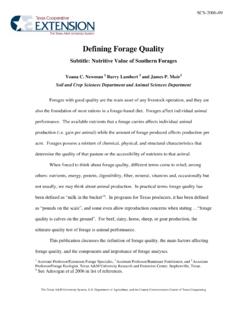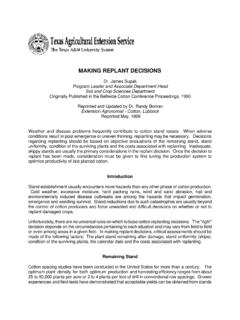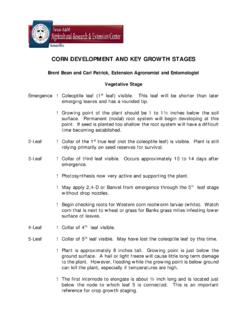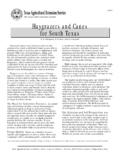Transcription of HYDROGEN SULFIDE IN DRINKING WATER
1 HYDROGEN SULFIDEIN DRINKING WATERC auses and Treatment AlternativesMark L. McFarland and T. L. Provin** Associate Professor and Extension WATER Quality Coordina-tor and Assistant Professor and Extension Soil Chemist,The Texas A&M University SystemDrinking WATER with a nuisance rotten egg odor contains HYDROGEN SULFIDE (H2S), a gas that dissolves readily in WATER . This SULFIDE -rich WATER commonly isreferred to as sulfur typical concentrations in household WATER are not a health risk, high concen-trations do affect the taste of WATER . A concentration as low as milligram hydrogensulfide per liter of WATER (mg/l) is detectable bysmell by most people. As a point of reference, 1teaspoon of salt dissolved in 1,000 gallons of waterproduces a concentration equal to about 1 mg/l. Acharacteristic HYDROGEN SULFIDE taste can bedetected in WATER with a concentration as low mg/l. Some people become accustomed to theodor and taste and tolerate HYDROGEN SULFIDE levelsas high as 5 to 6 mg/l.
2 Most people, unaccustomedto sulfur WATER , find it highly SULFIDE also can corrode plumbingmetals ( iron , steel, copper, brass) and exposedmetal parts in washing machines and other WATER -using appliances. Corrosion of iron and steel byhydrogen SULFIDE forms a black precipitate (ferroussulfide) that can stain laundry and bathroomfixtures, darken silverware and discolor copper andbrass of HYDROGEN sulfideHydrogen SULFIDE is formed by sulfur- andsulfate-reducing bacteria that can occur naturallyin WATER . These anaerobic bacteria use sulfates andsulfur compounds found in decaying plant material,rocks or soil to convert organic compounds intoenergy. Under these anaerobic (without oxygen)conditions, HYDROGEN SULFIDE forms as a SULFIDE can occur in deep or shallow wellsand also can enter surface WATER through , poorly constructed wells or thoselocated close to sewer lines or septic systems andsurface WATER can become contaminated withsewage and develop problems with hydrogensulfide.
3 Wells drilled in shale or sandstone or nearcoal or oil fields often will have HYDROGEN sulfidepresent in the from hot WATER onlyIn the home, the foul odor caused by hydrogensulfide sometimes is detected only on the hot waterside of taps. If the WATER heater is electric, theproblem might be caused by a chemical reactionwith the sacrificial metal rod (anode). Electricwater heaters often contain a magnesium rod thatfunctions to retard corrosion of the tank. As the rodreleases small amounts of magnesium, somehydrogen also is released. The HYDROGEN can thencombine with sulfur in the WATER to form hydrogensulfide. To correct the problem, the magnesium rodcan be removed or replaced by an aluminum or zincrod. However, such action could void the manu-facturer s warranty on the WATER heater. Chemicalfeeder systems using polyphosphate also can retardcorrosion, but generally are more hot WATER will have a sour smell,similar to that of an old damp rag.
4 This smell oftendevelops when the thermostat has been lowered tosave energy or reduce the potential for bacteria live and thrive in warmwater and can infest the WATER heater. The problemfrequently can be corrected by returning thethermostat to its recommended operating tempera-ture (approximately 160 degrees F) for 8 will kill the bacteria. (Caution: Be sure thewater heater has an operable pressure relief valvebefore increasing the temperature, and warnoccupants of the scalding hazard.) If a lower tem-perature is preferred for routine operation, periodichigh temperature flushing can be used wheneverthe odor for HYDROGEN sulfideThe cause of the HYDROGEN SULFIDE problem mustbe determined before proper testing and appropri-ate treatment can be applied. If the problem iscaused by HYDROGEN SULFIDE in the groundwater,then the concentration of the gas in the WATER mustbe measured in order to select and properly size atreatment system.
5 HYDROGEN SULFIDE gas dissolvesreadily in WATER and can readily escape from it(volatilize). Thus, WATER samples must be tested on-site, or immediately stabilized for laboratoryanalysis. Sample bottles withstabilizing chemicals shouldbe obtained from the labora-tory that does the sampling accordingto laboratory recommenda-tions is critical to ensureaccurate and reliable general, the requirementswill involve delivery of arefrigerated sample within48 hours of collection. Sulfideconcentrations are reportedby laboratories in units ofmilligrams per liter (mg/l) orparts per million (ppm).These two terms are the gas is being pro-duced by an active colony ofsulfur-reducing bacteria, thismust be determined. Activecolonies could be locatedanywhere within the plumb-ing system, well casing or inthe aquifer. Selected commer-cial WATER testing laborato-ries can determine thepresence of sulfur-reducingbacteria. If the bacteria are detected, treatment tocontrol the bacteria should eliminate the contaminants (sulfate, organic compoundsand metals) can cause taste and odor problems indrinking WATER .
6 WATER tests should always beconducted on new wells or when problems aresuspected in an existing WATER supply. This can beparticularly important if more than one contami-nant is involved because it will affect properdiagnosis of the problem and selection of the mosteffective and economical WATER treatment options forhydrogen sulfideThe recommended treatment to remove hydro-gen SULFIDE from a WATER supply depends largely onthe gas amounts of HYDROGEN SULFIDE ( - mg/l)Activated carbon adsorbs soluble organic com-pounds and certain gases, such as chlorine andhydrogen SULFIDE , that contribute tastes and odorsto a WATER supply. Very small amounts of hydrogensulfide can be removed from WATER with activatedcarbon filters ( ). Activated carbon is used as agranular form in tank-type filters and as finelydivided powder in a cartridge. The HYDROGEN sulfideis adsorbed onto the surface of the carbon 1. Point-of-use and point-of-entry placements of activated MeterFilterPoint-of-Entry (POE)To HouseholdPlumbingNonhouseholdPlumbingLin e BypassFaucet MountSome filters will improve taste, but will not elimi-nate unpleasant odors.
7 A granular filter must bebackwashed periodically; a cartridge filter must becleaned or replaced periodically. Cleaning frequencydepends on the amount of HYDROGEN SULFIDE in thewater and the volume of WATER treated. Moderate tohigh levels of HYDROGEN SULFIDE will require frequentfilter replacement. These filters also can removetannins and other dissolved organic than 2 mg/l HYDROGEN sulfideAeration (adding air to the WATER ) is a treatmentoption for this concentration range, and is commonlyused by city WATER treatment systems. Oxygen in theair reacts with HYDROGEN SULFIDE to form an odorless,dissolved form of sulfur called sulfate. Several typesof aeration systems are available. In one type,compressed air is injected into the WATER air then must be removed from the WATER toprevent knocking or air-blocks in the system and toreduce the corrosion potential caused by dissolvedoxygen. In another type, WATER is sprayed into anonpressurized storage tank (Fig.)
8 2). A second pumpis needed to re-pressurize the WATER . The storagetank provides 6 to 8 hours holding time for oxidationof HYDROGEN SULFIDE , iron and manganese. Thestorage tank and aerator must remain secure toprevent contamination of the WATER supply, or thesystem must be chlorinated. This process usuallyproduces a strong HYDROGEN SULFIDE odor near theaerator, and may not always reduce the hydrogensulfide to nondetectable levels. In such cases, acarbon filter can be used to remove some of theremaining trace amounts of HYDROGEN complex systems are not recommendedfor household 2. Nonpressurized aeration system from HYDROGEN SULFIDE PumpWell PumpWell Pressure TankGate/Ball Valve Aerator/DegasiferCheck ValveSecond Pressure TankTo WellUp to 10 mg/l HYDROGEN sulfideAn iron removal filter containing manganesegreensand can remove low to moderate levels ofhydrogen SULFIDE in addition to iron and manga-nese.
9 The process oxidizes HYDROGEN SULFIDE intosulfate; iron and manganese form precipitates thatare filtered out (Fig. 3). Manganese greensandfilters must be recharged with a solution of potas-sium permanganate when the oxygen is process is very similar to the regenerationprocess used in WATER softeners, and must beperformed at regular intervals of 1 to 4 weeksdepending on the chemical composition of thewater, size of the unit and amount of WATER pro-cessed. WATER with a pH below could requireacid neutralization, increasing the pH to to ,before iron removal will be effective. These filtersystems are very specialized and the installationand operation instructions of the manufacturershould be followed 3. Manganese greensand pressure filtrationsystem for removal of HYDROGEN SULFIDE , iron UnitFrom WellTo HouseManganeseTreated GreensandGravelFilterKMnO4 Feed TankKMnO4 SolutionUp to 75 mg/l HYDROGEN sulfideContinuous chlorination using an automaticchemical feed pump can effectively remove mediumto high levels of HYDROGEN SULFIDE (Fig.)
10 4). Chlorinequickly oxidizes HYDROGEN SULFIDE into a tasteless,odorless form. Continuous chlorination also effec-tively removes iron and manganese that can occurin association with HYDROGEN demand (concentration) and contacttime are very important to successful amount of chlorine needed to react withorganic and inorganic materials in the WATER canrange from 1 mg/l to more than 10 mg/l if the wateris high in SULFIDE , ammonia, iron or 1 presents typical dosages required to treatspecific time (exposure) depends on the concen-tration of chlorine in the WATER , WATER temperatureand pH. Oxidation of iron and HYDROGEN SULFIDE isinstantaneous, while manganese oxidizes moreslowly. Chlorine should be introduced into thesystem before it reaches the storage tank. The tankmust have sufficient volume to provide a 20-minutecontact time between the WATER and the addition, a fine-retention sediment filter can beused to remove any oxidized iron and free chlorine is undesirable and canproduce an objectionable taste in the WATER .









